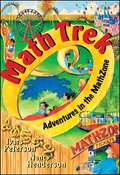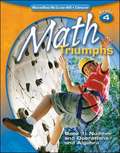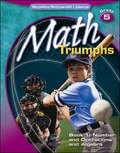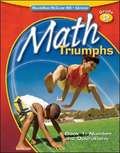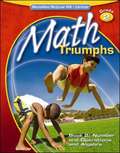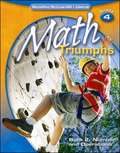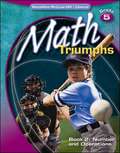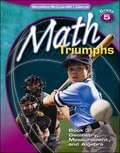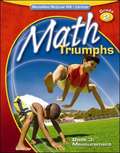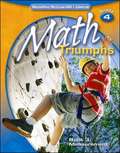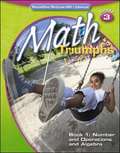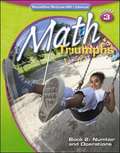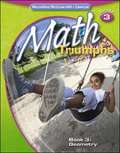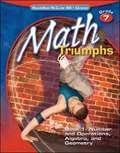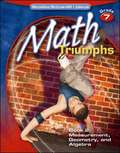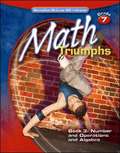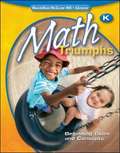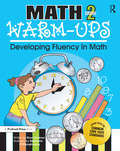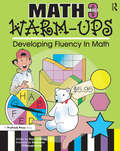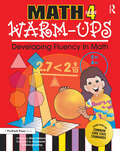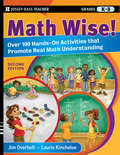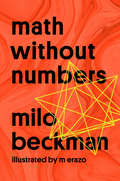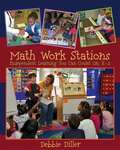- Table View
- List View
Math Trek: Adventures in the MathZone
by Ivars Peterson Nancy HendersonThere s a new amusement park in town. Come on in and find out all the exciting ways you can have fun with math in everyday life. Wander through the fractal forest, take a ride on the Mobius-strip roller coaster, and get dizzy learning about how math makes the Tilt-A-Whirl possible. The more activities you try, the more you'll learn how cool it can be to see the world through the eyes of a mathematician. <P><P>Once you've sampled some of the interesting and unique projects in Math Trek, from untangling unknots to winning games with weird dice to figuring out secret codes, you'll see that every trip to the MathZone is an exciting adventure!
Math Triumphs, Book 1: Number and Operations and Algebra, Grade 4
by Gonsalves Silbey Vielhaber Brown Basich Whitney DawsonNIMAC-sourced textbook
Math Triumphs, Book 1: Number and Operations and Algebra, Grade 5
by Gonsalves Silbey Vielhaber Brown Basich Whitney DawsonNIMAC-sourced textbook
Math Triumphs, Book 1: Number and Operations, Grade 2
by Gonsalves Silbey Vielhaber Brown Basich Whitney DawsonNIMAC-sourced textbook
Math Triumphs, Book 2: Number and Operations and Algebra, Grade 2
by Gonsalves Silbey Vielhaber Brown Basich Whitney DawsonNIMAC-sourced textbook
Math Triumphs, Book 2: Number and Operations, Grade 4
by Gonsalves Silbey Vielhaber Brown Basich Whitney DawsonNIMAC-sourced textbook
Math Triumphs, Book 2: Number and Operations, Grade 5
by Gonsalves Silbey Vielhaber Brown Basich Whitney DawsonNIMAC-sourced textbook
Math Triumphs, Book 3: Geometry, Measurement, and Algebra, Grade 5
by Gonsalves Silbey Vielhaber Brown Basich Whitney DawsonNIMAC-sourced textbook
Math Triumphs, Book 3: Measurement, Grade 2
by Gonsalves Silbey Vielhaber Brown Basich Whitney DawsonNIMAC-sourced textbook
Math Triumphs, Book 3: Measurement, Grade 4
by Gonsalves Silbey Vielhaber Brown Basich Whitney DawsonNIMAC-sourced textbook
Math Triumphs, Grade 3, Book 1: Number and Operations and Algebra
by Brown Basich Whitney DawsonNIMAC-sourced textbook
Math Triumphs, Grade 3, Book 2: Number and Operations
by Brown Basich Whitney DawsonNIMAC-sourced textbook
Math Triumphs, Grade 7, Book 1: Number and Operations, Algebra, and Geometry
by Brown Basich Whitney DawsonMath Triumphsis intended for use as a pull out intervention class (RtI level 3) for students who are struggling in mathematics concepts two or more grade levels below their current grade. It is designed for use in after school, before school, summer school, intercession, tutoring, or pull-out/resource rooms. .Math Triumphsis the first intervention program designed around the NCTM Focal Points..The Student Editions are 4-color, consumable Student Study Guide worktexts focusing on the foundational skills and concepts leading up to one of the three grade level Focal Points. Each chapter begins with a diagnostic assessment to identify concepts and skills that students may need to review or reinforce before introducing the new chapter..
Math Triumphs, Grade 7, Book 2: Measurement, Geometry, and Algebra
by Brown Basich Whitney DawsonMath Triumphsis intended for use as a pull out intervention class (RtI level 3) for students who are struggling in mathematics concepts two or more grade levels below their current grade. It is designed for use in after school, before school, summer school, intercession, tutoring, or pull-out/resource rooms. .Math Triumphsis the first intervention program designed around the NCTM Focal Points..The Student Editions are 4-color, consumable Student Study Guide worktexts focusing on the foundational skills and concepts leading up to one of the three grade level Focal Points. Each chapter begins with a diagnostic assessment to identify concepts and skills that students may need to review or reinforce before introducing the new chapter..
Math Triumphs, Grade 7, Book 3: Number and Operations and Algebra
by Brown Basich Whitney DawsonMath Triumphsis intended for use as a pull out intervention class (RtI level 3) for students who are struggling in mathematics concepts two or more grade levels below their current grade. It is designed for use in after school, before school, summer school, intercession, tutoring, or pull-out/resource rooms. .Math Triumphsis the first intervention program designed around the NCTM Focal Points..The Student Editions are 4-color, consumable Student Study Guide worktexts focusing on the foundational skills and concepts leading up to one of the three grade level Focal Points. Each chapter begins with a diagnostic assessment to identify concepts and skills that students may need to review or reinforce before introducing the new chapter..
Math Triumphs: Beginning Skills and Concepts, Grade K
by Gonsalves Silbey Vielhaber Brown Basich Whitney DawsonNIMAC-sourced textbook
Math Warm-Ups: Developing Fluency in Math (Grade 2) (Math Warm-ups Ser.)
by Sheri DisbrowThese success-proven exercises provide daily practice in various areas of math. There are 10 problems per page that reinforce and facilitate conceptual understanding in number sense, math reasoning, computation, time, money, measurement, geometry, probability, graphing, fractions, and decimals. The exercises systematically provide students opportunities to get practice in the most important math objectives each week and provide the teacher with immediate, easy-to-administer feedback on students' mastery.This workbook can be used as a warm-up, homework, or as a diagnostic tool for the teacher, parent, or administrator. The individual pages can be used to diagnose weak areas and provide opportunities to facilitate the students' full understanding of concepts. Students are challenged and consistently exposed to a variety of concepts in all objective areas. Each book spirals in level of difficulty and continues to encourage students to think about math in real-life situations.For math proficiency activities at more advanced levels, see Math Warm-Ups Grade 3 and Math Warm-Ups Grade 4.This series meets NCTM standards and builds test-taking proficiency.Grade 2
Math Warm-Ups: Developing Fluency in Math (Grade 3) (Math Warm-ups Ser.)
by Sheri DisbrowThese success-proven exercises provide daily practice in various areas of math. There are 10 problems per page that reinforce and facilitate conceptual understanding in number sense, math reasoning, computation, time, money, measurement, geometry, probability, graphing, fractions, and decimals. The exercises systematically provide students opportunities to get practice in the most important math objectives each week and provide the teacher with immediate, easy-to-administer feedback on students' mastery.This workbook can be used as a warm-up, homework, or as a diagnostic tool for the teacher, parent, or administrator. The individual pages can be used to diagnose weak areas and provide opportunities to facilitate the students' full understanding of concepts. Students are challenged and consistently exposed to a variety of concepts in all objective areas. Each book spirals in level of difficulty and continues to encourage students to think about math in real-life situations.For math proficiency activities at alternative levels, see Math Warm-Ups Grade 2 and Math Warm-Ups Grade 4.This series meets NCTM standards and builds test-taking proficiency.Grade 3
Math Warm-Ups: Developing Fluency in Math (Grade 4) (Math Warm-ups Ser.)
by Sheri DisbrowThese success-proven exercises provide daily practice in various areas of math. There are 10 problems per page that reinforce and facilitate conceptual understanding in number sense, math reasoning, computation, time, money, measurement, geometry, probability, graphing, fractions, and decimals. The exercises systematically provide students opportunities to get practice in the most important math objectives each week and provide the teacher with immediate, easy-to-administer feedback on students' mastery.This workbook can be used as a warm-up, homework, or as a diagnostic tool for the teacher, parent, or administrator. The individual pages can be used to diagnose weak areas and provide opportunities to facilitate the students' full understanding of concepts. Students are challenged and consistently exposed to a variety of concepts in all objective areas. Each book spirals in level of difficulty and continues to encourage students to think about math in real-life situations.For math proficiency activities at lower levels, see Math Warm-Ups Grade 2 and Math Warm-Ups Grade 3.This series meets NCTM standards and builds test-taking proficiency.Grade 4
Math Wise! Over 100 Hands-On Activities that Promote Real Math Understanding, Grades K-8
by Laurie Kincheloe James L. OverholtA fun, easy-to-implement collection of activities that give elementary and middle-school students a real understanding of key math conceptsMath is a difficult and abstract subject for many students, yet teachers need to make sure their students comprehend basic math concepts. This engaging activity book is a resource teachers can use to give students concrete understanding of the math behind the questions on most standardized tests, and includes information that will give students a firm grounding to work with more advanced math concepts.Contains over 100 activities that address topics like number sense, geometry, computation, problem solving, and logical thinking.Includes projects and activities that are correlated to National Math Education StandardsActivities are presented in order of difficulty and address different learning styles Math Wise! is a key resource for teachers who want to teach their students the fundamentals that drive math problems.
Math Without Numbers
by Milo BeckmanAn illustrated tour of the structures and patterns we call "math" The only numbers in this book are the page numbers. Math Without Numbers is a vivid, conversational, and wholly original guide to the three main branches of abstract math—topology, analysis, and algebra—which turn out to be surprisingly easy to grasp. This book upends the conventional approach to math, inviting you to think creatively about shape and dimension, the infinite and infinitesimal, symmetries, proofs, and how these concepts all fit together. What awaits readers is a freewheeling tour of the inimitable joys and unsolved mysteries of this curiously powerful subject. Like the classic math allegory Flatland, first published over a century ago, or Douglas Hofstadter's Godel, Escher, Bach forty years ago, there has never been a math book quite like Math Without Numbers. So many popularizations of math have dwelt on numbers like pi or zero or infinity. This book goes well beyond to questions such as: How many shapes are there? Is anything bigger than infinity? And is math even true? Milo Beckman shows why math is mostly just pattern recognition and how it keeps on surprising us with unexpected, useful connections to the real world. The ambitions of this book take a special kind of author. An inventive, original thinker pursuing his calling with jubilant passion. A prodigy. Milo Beckman completed the graduate-level course sequence in mathematics at age sixteen, when he was a sophomore at Harvard; while writing this book, he was studying the philosophical foundations of physics at Columbia under Brian Greene, among others.
Math Work Stations: Independent Learning You Can Count on K-2
by Debbie DillerIf you've ever questioned how to make math stations work, you'll find this photo-filled, idea-packed resource invaluable. This book extends Debbie Diller's best-selling work on literacy work stations and classroom design to the field of mathematics. In Math Work Stations you'll find ideas to help children develop conceptual understanding and skills, use math vocabulary as they talk about their mathematical thinking, and connect big ideas to meaningful independent exploration and practice. This book details how to set up, manage, and keep math stations going throughout the year. There's even a chapter devoted solely to organizing and using math manipulatives. Each chapter includes: key concepts based on NCTM and state math standards; math vocabulary resources and literature links; suggested materials to include at each station for the corresponding math content strand; ideas for modeling, troubleshooting, differentiating, and assessment; and reflection questions for professional development. Charts, reproducible forms, and math work stations icons are included to provide everything you'll need to get started with stations in your classroom right away.

